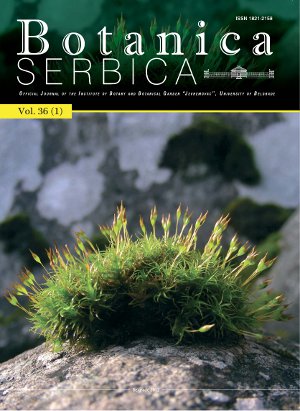
Volume 36 Issue 1 2012 |
Cylindrospermopsis raciborskii (Cyanoprokaryota) - potential invasive and toxic species in Serbia
|
KEY WORDS: Cylindrospermopsis raciborskii , Cyanoprokaryota, potential invasive species, Serbia |
The genus Verbascum L. in European Turkey
|
KEY WORDS: Verbascum, chorology, Flora of European Turkey. |
Distribution of the genus Ephedra (Ephedraceae) in Calabria (S Italy)
|
KEY WORDS: Calabria, chorology, Ephedra distachya subsp. distachya , Ephedra fragilis, Ephedra nebrodensis subsp. nebrodensis , phytogeography |
The phytogeography of European bryophytes
|
KEY WORDS: Bryophytes, Europe, phytogeography, endemism, disjunctions, relicts |
Conyza sumatrensis: a new alien plant in Romania
|
KEY WORDS: alien plant, Romanian flora, Conyza sumatrensis, invasive species |
Genetic variation among different accessions of Lathyrus sativus (Fabaceae) revealed by RAPDs
|
KEY WORDS: genetic diversity, grass peas, Lathyrus sativus, RAPDs, seling |
Comparative study of seed germination and seed vigour test in Andrographis paniculata (Acanthaceae)
|
KEY WORDS: Andrographis paniculata, cancer therapeutic, diterpenoid compound, kalmegh, germination, seed vigour |
Studies on the genus Atriplex L. (Amaranthaceae) in Italy. III. Atriplex macrodira Guss.
|
KEY WORDS: Amaranthaceae, Atriplex L. sect. Teutliopsis Dumort, Atriplex patula L., Giovanni Gussone, new combination, typii cation |
Seasonal and spatial dynamics of Stratiotes aloides (Hydrocharitaceae) plants
|
KEY WORDS: Stratiotes aloides, seasonal spatial dynamics of specimens, structural “weight” of leaves, starch content,ash content |
Retypification of two infraspecific names from Caryophyllaceae
|
KEY WORDS: typii cation, Heliosperma , Silene |
Symphyotrichum novae-angliae (Compositae) new alien species in Serbia
|
Based on our research in the i eld and the studies of herbarium material, we have found that S. novae-angliae is present in Serbia, both as cultivated ornamental plants, as well as a naturalized alien species. We have registered this species on 25 localities that are situated in 18 UTM 10 km x 10 km squares. Twenty two of the localities refer to a small group of individuals which are cultivated, while the remaining 3 i ndings relate to plants that have escaped from cultivation and have naturalized as a alien species. Size estimation of naturalized population s and detailed chorological data (locations of occurrences recorded with GPS, and distribution map presented at UTM grid squares of c. 10 km × 10 km) are presented KEY WORDS: Symphyotrichum, alien species, distribution, naturalization, Serbia |
University of Belgrade Herbarium – treasury of data and challenges for future research |


